
16th April 2000
News/Comment|
Editorial/Opinion| Business| Sports|
Sports Plus| Mirror Magazine

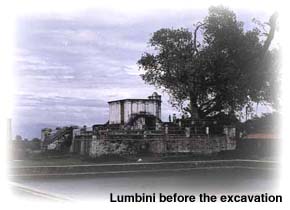
- Is Lumbini lost?
- Sri Lankaramaya: growing slowly
- Need for more air links
- Theatrical meditation on nature of art
- Guiding a film critic
- Corrupt sounds erode rich language
- Kala Corner - by Dee Cee
- So they say
- "The only man in her Cabinet"
- A tamping we will go
- Changing tracks: it's quick
- Driving home a point
- Equality and the public - Liberal Party proposala for a new Constitution
- Rights reporting caught in a war situ
- Vistas of great beauty and exquisite architecture
- Helping hand at Watersmeet
- Rehab on a hill far away
- Art for a cause
- Bringing sunshine to sunset years
- Chance to live and laugh
- Letters to the editor
- Bookshelf
- A taste of Sinhala 15
- Oddly Occupied
- Point of view I
- Point of view II








The birthplace of Lord Buddha is neglected and efforts to revive it seem slow
Is Lumbini lost?
By Tharuka Dissanaike
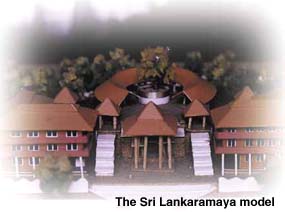 Lumbini
had a look of sad neglect about it. In the tall grass that covered its
vast acreage, in the half-dug, water-logged canals that attempted to form
an outer periphery, in the gravel roads that raised clouds of fine dust
with each vehicle, Lumbini looked mostly forgotten, not quite the focus
of a massive development plan executed by the Nepal government.
Lumbini
had a look of sad neglect about it. In the tall grass that covered its
vast acreage, in the half-dug, water-logged canals that attempted to form
an outer periphery, in the gravel roads that raised clouds of fine dust
with each vehicle, Lumbini looked mostly forgotten, not quite the focus
of a massive development plan executed by the Nepal government.
The birthplace of Lord Buddha, denoted by an Asoka pillar, is the centre of the Lumbini project area, which covers several square kilometres. The Mayadevi temple, which once stood here and was the centre of worship for Buddhist and Hindu pilgrims, stands no more. It was taken apart brick by brick for archaeological excavation by a Japanese team 10 years ago. Although the Japanese agreed to rebuild the temple over two years ago, no work has yet begun. The ruins of what was once the Mayadevi temple, now lay in organised stacks of brick, sheltered by a tin-roof canopy, by the side of the pillar.
The age-old statue, relief carving on stone-of the birth of Lord Buddha, which was found in the temple, is kept in a separate building for the time being. The carving, worshipped ardently through the ages as a symbol of fertility has lost its facial features and fine details.
The Lumbini Development Master Plan was drawn up by Japanese architect Kenzo Tange 20 years ago. Former UN Secretary General U. Thant, a Buddhist, had stressed the need for developing Lumbini as a centre for world peace — giving momentum to the project.
The UNDP donated US $ 1 million in technical assistance. Financial assistance has been flooding in from Buddhist countries and organisations, but Lumbini in reality has little to show in the way of development.
Tange's idea was to develop the area into a major tourist attraction and the focus of Buddhist worship. But two decades later Lumbini still lacks the basics — proper roads, transport, pilgrim facilities and restaurants. Connections from Kathmandu — 280 km away — are by air to the nearest town, Bairahawa (or Siddartha Nagar) or by ordinary bus, a journey that takes a good eight to nine hours. This town has a few hotels for visitors, but rates are touristy.
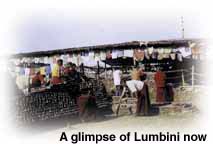 From
the town of Bairahawa, which sits on the Indian border, there are few options
to travel to Lumbini, 20 km away. No three-wheelers or taxis ply this city.
One would have to hire a jeep or take the disastrous public transport to
the dusty Lumbini junction. From then it would be on foot.
From
the town of Bairahawa, which sits on the Indian border, there are few options
to travel to Lumbini, 20 km away. No three-wheelers or taxis ply this city.
One would have to hire a jeep or take the disastrous public transport to
the dusty Lumbini junction. From then it would be on foot.
Many Sri Lankans who visit Lumbini opt to enter through India on the round tour of Buddhist pilgrimage sites that dot the northeastern states of India. They come through Bairahawa and spend less than half a day at Lumbini proper. Even if pilgrims did want to spend more time at Lumbini or exploring the ancient towns connected to Buddhist lore, there are sparse facilities in the way of transport or accommodation.
The Sri Lanka Pilgrims' Rest, situated close to Lumbini is a disgrace at best. The guesthouse was a gift by the Sri Lankan government to the development of Lumbini in 1993. Managed privately, it is in terrible condition — rooms unkempt, toilets leaking and general hygiene deplorable.
Many sites around Lumbini that are directly linked to the life of Lord Buddha are hardly visited by pilgrims. Most importantly Kapilavastu — the town presently called Tilaurakot — is just 27 km from Lumbini, but the road link is very bad. Here lie excavated ruins of the Kapilavastu citadel, capital of the Sakya kingdom ruled by King Suddhodana, Lord Buddha's father. The Eastern Gateway is particularly important as it was from here that the Buddha left his worldly life to find truth and enlightenment. The citadel was enclosed by a high wall and moat. A few kilometres away there is another Asokan pillar with ruins of a huge stupa.
"The entire district is a museum — a treasure trove of historical places
associated with the life of the Buddha," said Basantha Bidari, chief archaeologist
for the Lumbini Development Project.
Sri Lankaramaya: growing slowly
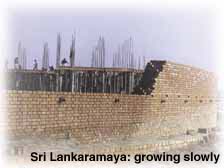 The
Sri Lankan gov ernment's Rs. 64 million project at Lumbini is taking gradual,
if a little slow, shape. Named the Sri Lankaramaya, the project in its
initial phase will consist of several buildings to house meditators and
a central statue of the enlightened Buddha under a Bo tree.
The
Sri Lankan gov ernment's Rs. 64 million project at Lumbini is taking gradual,
if a little slow, shape. Named the Sri Lankaramaya, the project in its
initial phase will consist of several buildings to house meditators and
a central statue of the enlightened Buddha under a Bo tree.
"We hope to plant the Bo sapling by November," said Project Architect Lalith Mutukumarana. "Before then we have to finish the extensive earth filling work."
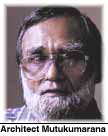 A
moat will encircle the entire Phase One area, an acre and a half. The land
within will be raised some 30 feet from the present ground level, in several
tiers, narrowing with height.
A
moat will encircle the entire Phase One area, an acre and a half. The land
within will be raised some 30 feet from the present ground level, in several
tiers, narrowing with height.
The Bo tree will be planted on the top of the mound, underneath it will be placed the statue of the Buddha in the samadhi posture facing the entrance to the complex.
The second phase of the project, on a block of land opposite the present site, will see an elevated stupa and sanghavasa (dwelling for monks), as well as facilities for pilgrims visiting the sacred area.
The marshy soil in the project area makes it necessary to fill the land.
By elevating the Bo tree by as much as 30 feet from ground level, the Sri Lankaramaya would be visible at a long distance in the flat Lumbini countryside, said Mutukumarana.
"The design of the complex is based on Buddhist philosophy. In the first phase I have tried to incorporate the concept of the noble eight fold path in the building layout," Mutukumarana said. A mixture of Sri Lankan indigenous architecture, the design draws from Kandyan, Anuradhapura and Polonnaruwa era buildings.
At the entrance a classic half-moon sandakada pahana and makara thorana will greet visitors. A reflecting pond will catch glimpses of the Siddartha pavilion -which will house sculpted images of the birth of Lord Buddha.
"We are presently thinking of a mural in three dimensional effect," said Mutukumarana. Through the open, high ceilinged pavilion visitors will be able to see the statue of the Buddha under the Bo tree, high above them.
He said : "At the same time people will see the birth of Lord Buddha and see the Enlightened One high up there.
" To reach the foot of the tree, I designed two flights of steps. Each in eight sections. These two stairways are reminders of the noble eight-fold path preached by the Buddha.
"The stairways will be decorated by a continuous balustrade of kneeling elephants, their trunks forming an arch above the steps."
At the summit pilgrims will see the Enlightened Buddha.
Around the Bo tree there will be areas for meditation. Meditators could also use the tree-lined lower terraces for silent contemplation of the tree, Mutukumarana said.
"The two buildings on either side of the stairway will consist of rooms for meditators, living quarters with toilets and kitchens, a library, large lobby and hall areas," said project engineer at the site, Ranjith Gunadasa.
The construction work, which commenced in December 1998, is expected
to end in 2001. The project is the brainchild of the Ministry of Buddha
Sasana and is executed through the Central Cultural Fund, which is supplying
technical assistance to build the complex.
Need for more air links
"We have to encourage more Sri Lankans to visit Lumbini," Sri Lankan
Ambassador in Nepal, Pamela Deen said. "Most Sri Lankans being Buddhist
would certainly want to visit this holy place in their lifetime."
Ms. Deen said that direct air links from Kathmandu to Colombo would greatly help increase the number of Sri Lankans visiting Lumbini. "Today pilgrims come through India and spend so little time in what is one of the most important sites of Buddhist worship. There is so much more to see around Lumbini. So much history that many Sri Lankans learn in their Buddhism lessons that can actually be seen and experienced here."
The Ambassador said that SriLankan Airlines should look at better air connections between Colombo and Kathmandu. Linking the two capitals could prove beneficial for both countries as tourism is big business in both destinations.
Ms. Deen also said that the Sri Lankan government was taking up the issue of the Sri Lankan Pilgrims' Rest at Lumbini. "The management contract has been awarded by tender and will continue until 2003. Until then we will insist that the place be maintained at a better standard or ask the name to be changed, since it implies that the guesthouse is run by Sri Lankans."
Ms. Deen also said that the Sri Lankan government has sought explanation from the Nepal Ministry of Culture about the deplorable state of the guesthouse and inappropriate activities — weddings and parties — that go on there, despite the building being in a holy location.
![]()
Front Page| News/Comment| Editorial/Opinion| Plus| Business| Sports| Sports Plus| Mirror Magazine
Please send your comments and suggestions on this web site to

